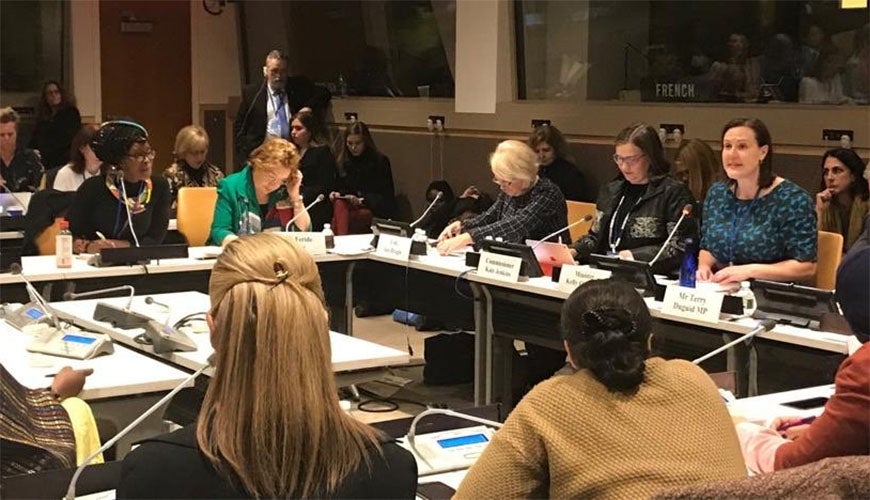63rd Session of the United Nations Commission on the Status of Women

Australian & Canadian government & Australian Human Rights Commission side event:
Sexual harassment in the workplace – a global perspective
Monday 11 March, 1.15pm – 2.30pm
Location: Conference Room 11, UN Headquarters
Keynote address – Kate Jenkins, Australian Sex Discrimination Commissioner
Ishaani’s story
Ishaani is a migrant worker. She is a young woman who came to Australia from Cambodia in search of a better life. Ishaani was delighted to secure work picking fruit in rural Australia, which provided her both income and accommodation.
Ishaani was repeatedly molested by a cash contractor living in the same house as her. The contractor told her that she would lose her job and visa if she didn’t submit to his demands. With language barriers and a lack of understanding of Australian workplace rights plus visa fears, it was only when Ishaani met a local union representative that she learnt that this behaviour was unlawful sexual harassment.
Ishaani’s story is not an Australian story, it is a global story. From the other side of the world, it is the other side of the Harvey Weinstein story. It is a story that reflects the global experience of sexual harassment, which happens in every location (from metropolitan Los Angeles to regional Australia); in every industry (from Hollywood to farming); and to all cohorts (including actresses and young migrant workers).
Introduction
Good afternoon everyone and thank you Purna for your introductions.
I would like to acknowledge the traditional owners of this place and pay my respects to their ancestors who cared for this island.
I’d like to thank the Australian Minister for Women, the Hon. Kelly O’Dwyer, as well as Terry Duguid, Canadian MP and Parliamentary Secretary to the Minister for Women and Gender Equality for your opening remarks, and leadership on the issue of gender equality and workplace sexual harassment.
Two years ago, a standing-room only session focusing on global efforts to eliminate sexual harassment to create safe and fair workplaces on day 1 of CSW would have been unimaginable. Now, it is essential.
Sexual harassment context in Australia
Let me set some context for you on Australia’s journey in sexual harassment laws.
Women’s organisations in Australia began to press for the legal and social recognition of sex discrimination in the early 1970s.
This movement built on Australia’s ratification of two key international conventions:
- the International Labour Organisation’s Discrimination (Employment and Occupation) Convention ('ILO Convention 111') in 1973; and
- the UN Convention on the Elimination of All Forms of Discrimination Against Women (‘CEDAW’) in 1983
States including South Australia, New South Wales and Victoria enacted anti-discrimination laws covering the ground of sex in the late 1970s.
In 1984, the federal government introduced the Sex Discrimination Act which specifically prohibits sexual harassment at work, as well as established my role of Sex Discrimination Commissioner.
Since 1984, successive Sex Discrimination Commissioners have identified the elimination of workplace sexual harassment as a key priority.
While these laws are a very significant development, the reality is that sexual harassment at work remains pervasive and occurs across all industries and workplaces in Australia, as it does across the rest of the world.
Since 2003, the Australian Human Rights Commission has conducted 4 periodic surveys on the national experience of sexual harassment. Our most recent 2018 survey found that 1 in 3 Australian workers have experienced sexual harassment in the last 5 years.
Australia’s National Sexual Harassment Inquiry
Australia has been able to act on sexual harassment because of 3 important co-existing factors:
- The global #MeToo conversation has shone a light on the ongoing pervasiveness of sexual harassment at work across the globe, and generated a resurgence of public concern on this issue.
- We have a Minister for Women in the Hon. Kelly O’Dwyer who is deeply committed to advancing women’s economic empowerment and eliminating barriers like sexual harassment at work.
- We have a National Human Rights Institution which is empowered with the special function of a National Inquiry- a powerful tool for investigating systemic discrimination and human rights violations, as well as educating the broader community about the issue under examination.
This is why in June 2018, I announced the National Inquiry into Sexual Harassment in Australian Workplaces, alongside the Minister O’Dwyer.
Under its Terms of Reference, the National Inquiry will examine:
- the nature and prevalence of sexual harassment in Australian workplaces;
- its drivers and impacts including the economic cost to Australia;
- the adequacy of the current legal framework;
- the implications of evolving technology on sexual harassment; and
- measures to address this harassment.
As well as being an Australian first, this National Inquiry is a world first.
I am incredibly proud that the Australian government has taken such decisive action on this issue, and that the National Inquiry has received such widespread support from government, unions, employers and the community.
What we are hearing – key themes
Since September last year my team and I have been travelling across Australia to cities and regional areas, speaking to workers, employers, unions, government representatives, policy specialists, advocacy organisations and the public about their experiences and ideas for change.
We are beginning to draw together the full picture in all of its complexity, and some very clear key themes are emerging time and time again. These are some of the themes we are hearing:
- Key drivers of sexual harassment at work include: abuse of power; gender inequality; normalisation of and tolerance for sexualised conduct within the workplace; as well as poor responses to complaints, a lack of consequences for sexual harassment, and a lack of diversity in leadership ranks.
- Sexual harassment occurs in every industry, in every location and at every level, but: (a) some industries face additional risk factors - such as gender segregated workforce’s; remote and isolated workplaces; work in the gig economy; and (b) some groups of people are more at risk, for example - migrant workers; workers with a disability, LGBTI workers; young workers; and people on casual or short-term contracts.
- The impacts are serious and enduring for everyone involved. Individuals experience mental health issues and there is a negative impact on long-term employment prospects, resulting in many people changing jobs, industries or leaving the workforce all together. There are broader impacts on the harasser, co-workers, family and friends, as well as costs to business and the economy.
- The legal framework in Australia relies primarily on the bravery and perseverance of victims to complain and enforce the laws, and in many cases navigate more than one complex legal jurisdiction. Yet workers overwhelmingly do not want to report sexual harassment, and when they do they are often victimised for doing so. We need to move responsibility from the shoulders of victims to the proper duty holders- the workplaces, government & perpetrators.
Conclusion
I am confident that this wide-ranging, extensive National Inquiry will deliver solutions that are practical and evidence-based to prevent and effectively address sexual harassment in the workplace.
We will report on our findings in the second half of this year.
While the National Inquiry focuses on the Australian context, there is no doubt that our findings will have relevance internationally, and I look forward to being able to share our learnings with the international community.
Sexual harassment is a global phenomenon that requires partnerships across borders to drive durable change. We cannot underestimate the way in which learning about approaches to preventing and effectively responding to sexual harassment across jurisdictions can open our minds to new possibilities.
We can all ensure that Ishaani’s story has a happy ending.
Thank you.

